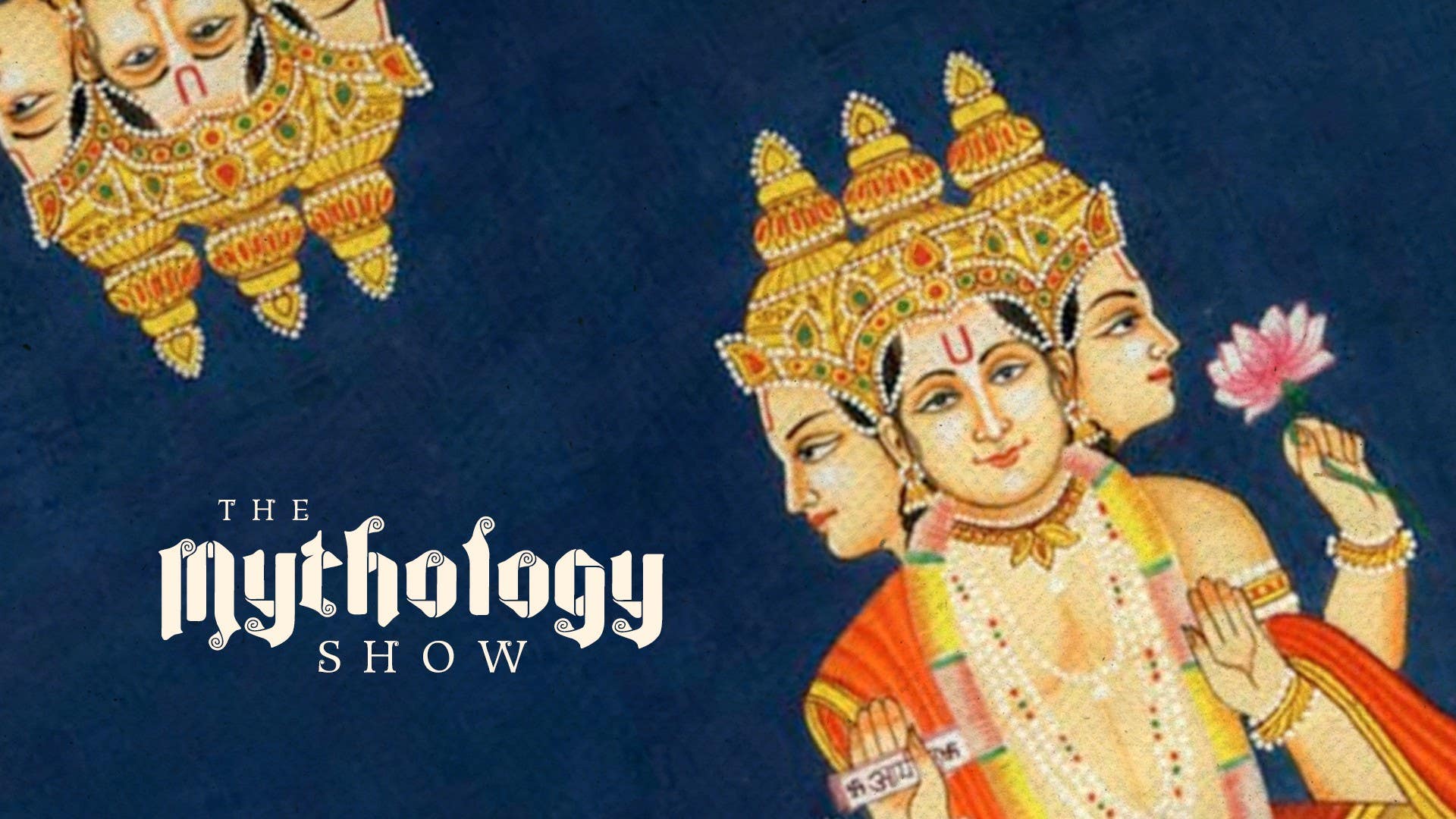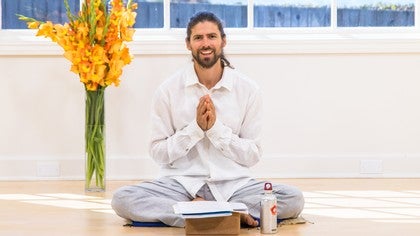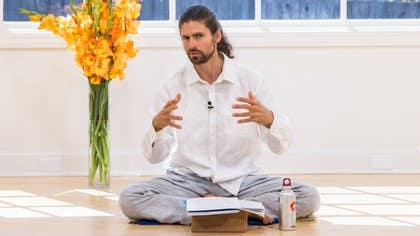Description
About This Video
Transcript
Read Full Transcript
Om Gananam Tva Ganapategama Vamahe Kavinkavina Mupamashravastam Jesta Rajam brahmana brahmana sphutte aanashen vanu te bessi rasaranam Om Gomtat Purushaya Vitmahi Va Kritundayati Mahi Tanurantev Prachura Yatim Om Gananapatayinama Om Gananapatayinama Anshri Maha Ganapatayinama So welcome to Yoga and Mythology. So that was an invocation to Ganesha. And generally in Yoga, when we go into the realm of mythology, archetype and symbol, we always start with Ganesha and later we're going to find out why. But before that, I'd just like to address the idea of why mythology is part of the yoga path, why it features perhaps so prominently in yogic presentations. So yoga is the practical school of Indian philosophy.
And being practical, it recognizes that we're made of many different parts and also we're all unique. Every individual human being has their own idiosyncrasies, let's say, and we learn in slightly different ways. Also, sometimes the ways we learn change over time and different learning approaches are more effective at different stages in our life or in different situations. So before we get into that, I'd just like to clarify how I'm talking about yoga. And that is, yoga is basically the practical school of Indian philosophy and its search or quest or aim is to bring about integration, harmony, cohesion, here and now in the thick of life, in the middle of all of this change, all this opportunity, all these different types of experience.
How can we actually know a sense of wholeness, fullness, balance and integration even as the world keeps turning and change is happening so fast? That's what I mean when I'm talking about yoga here. Now, if we want to stay balanced amidst all this change, yoga recognizes that we're made of different parts. So to keep them all in balance isn't always so straightforward because yoga reminds us that it's quite likely there are parts of ourselves that we don't really know very well. And so one of the main thrusts or aims of yoga practice or investigation is to usher us towards a deeper understanding of all of who we are.
And this involves working with parts of ourselves that we might not be so familiar with or confident about or even aware of. And so this begs something of a question. How can we start to work with parts of ourselves that we don't know very well and we're not even sure exist? And this is one of the beautiful things about the use of story and mythology in the Indian yoga tradition. Because one of the beautiful things about story is that while we receive it through the mind, story can often move us at an emotional level.
Sometimes the descriptions can even create a kinesthetic experience and we can feel and taste and sense things once we get into the story. So one of the wonderful things about story is it can kind of facilitate a yogic involvement, in other words an integrated total involvement in the present moment. Maybe you've experienced being lost in a story or absorbed in a story. I think that's a better way of saying it, to be absorbed in it. Now in the Indian system the way that story is generally referred to in a yogic context is this beautiful word, excuse me, Purana.
But maybe that Freudian slip of saying beautiful world is not inappropriate because in Purana the stories open up this whole world of imaginative resonance. Because when we get into the realm of story, certain inhibitions and certain limitations immediately get transcended. We have the opportunity to explore realms that in our particular day to day might not be so readily accessible. And so one of the wonderful things with story is they can kind of invite us into these frontier lands of our own psyche. That ordinarily we don't get so much chance to interact with.
So for example, the very first Purana that I encountered was not an Indian one, strictly speaking. Even though one of the most important characters in this epic had a Sanskrit name. That name being Yoda, which actually means warrior in Sanskrit. But Yoda, he's a yogic warrior. He's not a violent character. He's one who knows how to be in balance because he feels the force.
He's very attentive to everything all around him. He's got to know all the parts of himself very, very well. And the Star Wars epic, when I was a little boy, it allowed me to imagine and to connect to the types of situation that as a four-year-old I had not yet had a chance to actually live out myself. But it kind of opened up the idea that our life involves these types of challenges and these are different types of response or approach. If I were to ask, for example, what is the most celebrated play in the English language?
People might respond in different ways, but I'm imagining that many people would say Hamlet. And I consider Hamlet Purana. I first studied Hamlet when I was 16 years old and I just loved it. And so did many of my friends because we felt like the lines are so dripping with truth. They're speaking about our life.
This play is set in a particular location, Denmark, at a time, kind of some time in the past, and yet it's teaching us about now. Pura in Sanskrit means ancient or long ago. And Purana means that which is ancient but is always fresh. It gets such a beautiful word because it's reminding us that what's set down in the story or the myth, even if it's set in a galaxy far, far away, a long, long time ago, it's actually about now. It's actually about the actuality of our human experience.
And so what makes something Purana is that it's actually telling us the truth. The myth or the fantasy, the play, the story that's full of imagination, it's speaking to us across limits of time and space. And so in the Indian Puranic realm, we have these wonderful characters. They're often quite fantastical, but the idea is they can speak to us very readily because the concerns and the symbols of the story are not confined to any particular place or time. They're really dealing with what we all have to deal with in the course or what we might term the story of a human life.
So this is the rich land that we're going to explore as we start to get into Purana. Now, before we get into Purana, there's another thing I'd like to kind of highlight about the gift of story, is that for me, storytelling, this may be a rather romantic notion, but not very long ago, gathering around to hear and share story and to actually participate in it was one of the main ways that humans entertain themselves. If you think of the word entertain, it means it holds your attention from the Latin. It holds your engagement. Now, is that when a story really works on you, when you really allow yourself to receive it, it's not a very passive thing.
You have to listen and conjure your own imagination. You have to kind of transplant yourself into the shoes or sandals or bare feet of the different characters in that story. And so it invites you to engage in this very interesting way that's not just at the level of the mind. Because once you get into the story, the characters are having sensory experiences. They're moving, and there's also this wonderful emotional quality to story.
So one way we can consider yoga as a path to integration is one of transformation. If we are longing for peace or wholeness, then it's a telltale sign that we don't really fully know it. So if we don't really know peace or wholeness or wellness, how can we approach it? And this brings us right away into contact with this limitation of this wonderful gift of the mind. The mind, wonderful power tool that it is, has certain limitations.
And one of its principal limitations is that it struggles with things it's never really experienced before. And so story can be particularly powerful in the way that when we receive a story, we receive it through the lens of the mind. The mind is involved. But as the story stirs our emotional engagement and kind of reaches into the realm of our sensory and kinesthetic potential, it almost invites the mind to cross into frontier lands that it's not so familiar with and give it the experience, that rich, how to say, that safe experience that allows the mind to kind of relax into a collaborative effort with the emotional intelligence, with the kinesthetic intelligence, with the sensory intelligence. So story really is just an invitation.
And really that's what yoga press is all about. It's about inviting more and more of ourself into the present moment.
The Mythology Show: Ganesha with James Boag
Comments
You need to be a subscriber to post a comment.
Please Log In or Create an Account to start your free trial.












